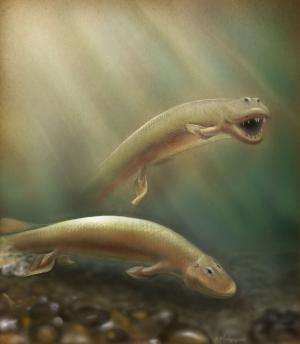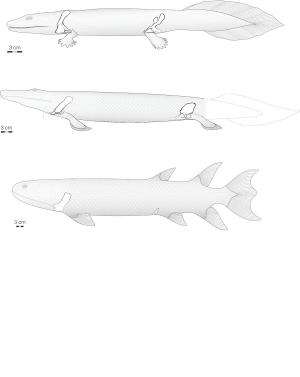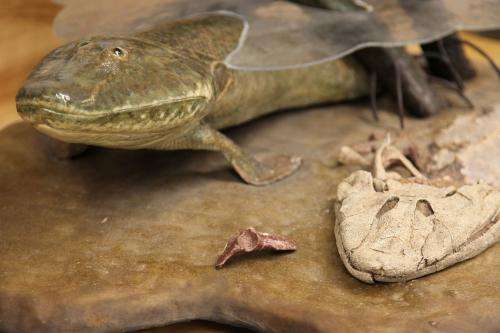Tiktaalik roseae fossil analysis provides new details on the origin of vertebrate legs

The discovery of well-preserved pelves and a partial pelvic fin from Tiktaalik roseae, a 375 million-year-old transitional species between fish and the first legged animals, reveals that the evolution of hind legs actually began as enhanced hind fins.
This challenges existing theory that large, mobile hind appendages were developed only after vertebrates transitioned to land. The fossils are described by scientists in the Proceedings of the National Academy of Sciences, online on Jan. 13.
"Previous theories, based on the best available data, propose that a shift occurred from 'front-wheel drive' locomotion in fish to more of a 'four-wheel drive' in tetrapods," said Neil Shubin, PhD, Robert R. Bensley Distinguished Service Professor of Anatomy at the University of Chicago and corresponding author of the study, which marks his inaugural article as a member of the National Academy of Sciences. "But it looks like this shift actually began to happen in fish, not in limbed animals."
Discovered in 2004 by Shubin and co-authors Edward Daeschler, PhD, Associate Curator of Vertebrate Zoology at the Academy of Natural Sciences of Drexel University, and the late Farish A. Jenkins, Jr., PhD, of Harvard University, Tiktaalik roseae represents the best-known transitional species between fish and land-dwelling tetrapods.
A lobe-finned fish with a broad flat head and sharp teeth, Tiktaalik looked like a cross between a fish and a crocodile, growing up to a length of 9 feet as it hunted in shallow freshwater environments. It had gills, scales and fins, but also had tetrapod-like features such as a mobile neck, robust ribcage and primitive lungs. In particular, its large forefins had shoulders, elbows and partial wrists, which allowed it to support itself on ground.
However, only specimen blocks containing the front portion of Tiktaalik have been described thus far. As the researchers investigated additional blocks recovered from their original and subsequent expeditions to the dig site in northern Canada, they discovered the rear portion of Tiktaalik, which contained the pelves as well as partial pelvic fin material. The fossils included the complete pelvis of the original 'type' specimen, making a direct comparison of the front and rear appendages of a single animal possible.
The scientists were immediately struck by the pelvis, which was comparable to those of some early tetrapods. The Tiktaalik pelvic girdle was nearly identical in size to its shoulder girdle, a tetrapod-like characteristic. It possessed a prominent ball and socket hip joint, which connected to a highly mobile femur that could extend beneath the body. Crests on the hip for muscle attachment indicated strength and advanced fin function. And although no femur bone was found, pelvic fin material, including long fin rays, indicated the hind fin was at least as long and as complex as its forefin.

"This is an amazing pelvis, particularly the hip socket, which is very different from anything that we knew of in the lineage leading up to limbed vertebrates," Daeschler said. "Tiktaalik was a combination of primitive and advanced features. Here, not only were the features distinct, but they suggest an advanced function. They appear to have used the fin in a way that's more suggestive of the way a limb gets used."
Tiktaalik pelves were still clearly fish-like, with primitive features such as an undivided skeletal configuration, as opposed to the three-part pelvic girdle of early tetrapods. However, the expanded size, mobility and robusticity of the pelvic girdle, hip joint and fin of Tiktaalik made a wide range of motor behaviors possible.

"It's reasonable to suppose with those big fin rays that Tiktaalik used its hind fins to swim like a paddle," Shubin said. "But it's possible it could walk with them as well. African lungfish living today have similarly large pelves, and we showed in 2011 that they walk underwater on the bottom." (For a video of a walking lungfish see: phys.org/news/2011-12-small-lu … h-big-evolution.html ).
"Regardless of the gait Tiktaalik used, it's clear that the emphasis on hind appendages and pelvic-propelled locomotion is a trend that began in fish, and was later exaggerated during the origin of tetrapods," Shubin said.
More information: "Pelvic girdle and fin of Tiktaalik roseae," by Neil Shubin, Edward B. Daeschler, Farish A. Jenkins, Jr. www.pnas.org/cgi/doi/10.1073/pnas.1322559111
Journal information: Proceedings of the National Academy of Sciences
Provided by University of Chicago Medical Center




















